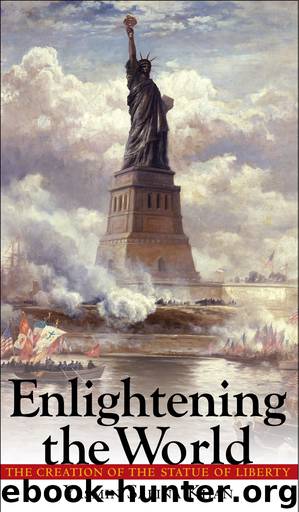Enlightening the World: The Creation of the Statue of Liberty by Khan Yasmin Sabina

Author:Khan, Yasmin Sabina
Language: eng
Format: epub
ISBN: 978-0-8014-6360-0
Publisher: Cornell University Press
8
THE STATUE TAKES SHAPE
By early 1872 Bartholdi was close to completing his design for the statue. It would not be until September 1875, however, that Édouard Laboulaye was ready to launch the project with a public announcement of their plans. The primary reason for this three-year delay was political. Although a republic had been proclaimed at the beginning of the Franco-Prussian War of 1870–71, in practice the governance of France did not follow this abrupt shift. Certain steps were taken to move in this direction. Elections were held again in 1871 and, for the first time, Laboulaye was seated in the National Assembly. He chaired the committee for the reorganization of public instruction in France and began drafting ideas for constitutional laws for a representative government. Despite the efforts of Laboulaye and others to formulate a structure and a constitution for the new government, the strength of the reactionary members in the assembly in the years immediately after the war threatened the survival of the republic altogether. Residual distrust of Parisians prevented the government from moving back to the capital from Versailles (it finally returned in 1879) and, exemplifying the republic’s difficult beginning, Marshal Patrice de MacMahon was selected president. MacMahon’s government of “moral order,” recorded the U.S. minister in Paris, Elihu Washburne, restricted liberty of speech and exercised powers that “had never been exercised during the worst times of [Napoleon III’s] Empire.”
Members of the assembly were divided regarding the preferred form of government for France, with some favoring a return to monarchy or empire. By 1873, however, most members agreed on the importance of securing a stable, permanent government to preclude another slide into revolution. A committee was established to draft constitutional legislation, to which Laboulaye devoted much effort. He advocated borrowing features of the American system, namely the bicameral legislature and a president in an executive branch. To his delight the constitutional laws were adopted in early 1875, together with an amendment confirming that the “government of the Republic is composed of two chambers and of a president.” Although passing by only one vote, 353 to 352, the Wallon Amendment’s reference to France as a republic signaled an end to the dispute of the past four years. Those who favored a change from autocratic government to one based on respect for individual liberty had succeeded in setting the direction of France’s future governance.
During these years, as Laboulaye waited for the opportune moment to announce the liberty statue project, Bartholdi investigated means for its construction. He needed to determine how, and of what material, the sculptural form would be built, and how this form would be supported. For advice on the first issue, Bartholdi turned to a metalwork foundry located in the city, the firm of Gaget, Gauthier & Co. (formerly known as Monduit and Bechet). The foundry had considerable experience with statuary and decorative art, especially in copper. Its work included large-scale projects such as the domes for the new Paris opera house, statues for the spires of
Download
This site does not store any files on its server. We only index and link to content provided by other sites. Please contact the content providers to delete copyright contents if any and email us, we'll remove relevant links or contents immediately.
| Africa | Americas |
| Arctic & Antarctica | Asia |
| Australia & Oceania | Europe |
| Middle East | Russia |
| United States | World |
| Ancient Civilizations | Military |
| Historical Study & Educational Resources |
Cat's cradle by Kurt Vonnegut(15178)
Pimp by Iceberg Slim(14376)
4 3 2 1: A Novel by Paul Auster(12281)
Underground: A Human History of the Worlds Beneath Our Feet by Will Hunt(12022)
The Radium Girls by Kate Moore(11921)
Wiseguy by Nicholas Pileggi(5669)
Perfect Rhythm by Jae(5322)
American History Stories, Volume III (Yesterday's Classics) by Pratt Mara L(5255)
The Fire Next Time by James Baldwin(5246)
Paper Towns by Green John(5086)
Pale Blue Dot by Carl Sagan(4907)
A Higher Loyalty: Truth, Lies, and Leadership by James Comey(4840)
The Mayflower and the Pilgrims' New World by Nathaniel Philbrick(4420)
The Doomsday Machine by Daniel Ellsberg(4415)
Killers of the Flower Moon: The Osage Murders and the Birth of the FBI by David Grann(4385)
The Sympathizer by Viet Thanh Nguyen(4305)
Too Much and Not the Mood by Durga Chew-Bose(4270)
The Borden Murders by Sarah Miller(4235)
Sticky Fingers by Joe Hagan(4100)
